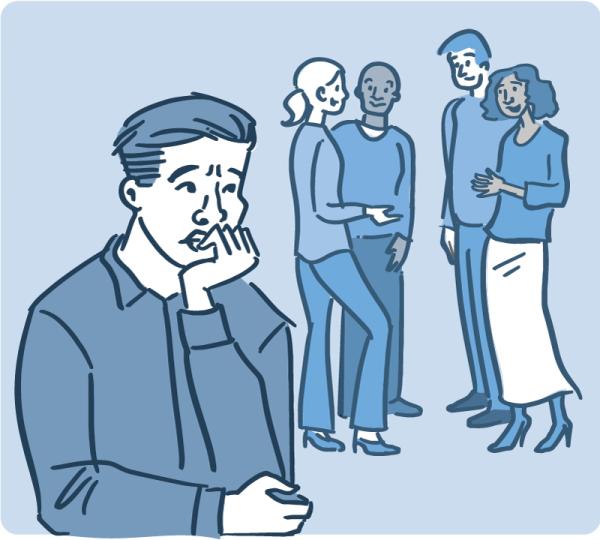Which Neurons Are Responsible for Anxiety-Related Behaviors?

Severe anxiety can cause people to avoid situations like traveling on a plane or socializing with others. IRP researchers have identified a population of brain cells that appear to underlie anxiety-related behaviors in mice. Image courtesy of NIH News in Health.
Most people experience anxiety at some point in their lives, whether it’s pre-speech jitters or sweaty palms when their plane takes off. While mild feelings of nervousness are completely normal and can even be beneficial, anxiety can also have negative repercussions if it causes somebody to completely avoid situations like social encounters or taking a flight to visit distant family.
In a series of experiments, IRP researchers identified a specific set of neurons that appear to underlie certain fear-related avoidance behaviors in mice, potentially representing a useful target for treating human anxiety disorders.1
Although mice enjoy surveying their surroundings, their position as the lowest link on the food chain makes them averse to brightly lit, open spaces where they might be snatched up by a hungry hawk. The way mice balance the risks and rewards of exploration mirrors many situations that can make humans anxious, says IRP investigator Alexxai V. Kravitz, Ph.D., the study’s senior author.
“If you’re buying a house, you’re going to have a lot of excitement, but once the time to sign the contract comes, you’re going to think about the risks you’re taking and whether this is the right decision,” Dr. Kravitz explains. In other words, if signing makes you too nervous, you might just scrap the whole deal.
Past studies have suggested neurons that receive signals via the chemical dopamine in a brain area called the striatum are involved in assessing risk and reward and play a role in avoidance behaviors, as well as social phobia and some anxiety disorders. In the current study, IRP scientists led by first author Kimberly LeBlanc, Ph.D., a postdoctoral fellow in Dr. Kravitz’s lab, first examined the behavior of mice that did not have a specific dopamine receptor, the dopamine D2 receptor, in those striatal neurons. Since dopamine receptors convert dopamine-based signals into useable messages, this lack of dopamine receptors made the neurons less sensitive to dopamine-based communication.
Compared to control mice with intact D2 receptors throughout their brains, mice that lacked the D2 receptor in striatal cells called indirect medium spiny neurons (iMSNs) spent less time in open spaces during behavioral tests that allowed them to freely move between enclosed and open areas. Importantly, these behavioral changes were independent of overall changes in the animals’ movements, so the mice did not stay in the enclosed areas simply because they were moving around less. Mice missing the D2 receptor in other populations of neurons did not differ from the control mice, suggesting D2 receptors specifically in the iMSNs are important for avoidance behaviors in mice.
“Knocking out this receptor alters the timing of these neurons’ activity,” Dr. Kravitz explains. “Normally, the activity of all the neurons in the brain is very precisely timed, like a piece of music, and it produces this very nice synchronized behavior. If the timing of this activity is altered — like, say, one neuron fires a second too early and another one a second too late — the animal gets stuck in a state where it’s not executing these exploratory movements.”
Similarly, when Dr. Kravitz’s team directly disrupted the timing of iMSN activity in genetically normal mice, the animals became more risk averse and spent less time in open spaces. On the other hand, when the scientists inhibited those neurons, the mice spent more time in the exposed areas.
“Knowing that this cell type is important for anxiety-related behaviors, you can drill down and ask how you can gain pharmacological access to this system,” Dr. Kravitz says. “Is there a drug that would preferentially act on these neurons?”
However, because there are so many varieties of anxiety disorders, Dr. Kravitz cautions that designing treatments to tamp down the activity of those cells may not be a panacea.
“Anxiety disorders are incredibly hard to treat because there’s not just one problem where everyone can have the same treatment,” he explains, “so even if this work is successful, it might help only a subset of people with severe anxiety.”
Subscribe to our weekly newsletter to stay up-to-date on the latest breakthroughs in the NIH Intramural Research Program.
References:
[1] Striatopallidal neurons control avoidance behavior in exploratory tasks. LeBlanc KH, London TD, Szczot I, Bocarsly ME, Friend DM, Nguyen KP, Mengesha MM, Rubinstein M, Alvarez VA, Kravitz AV. Mol Psychiatry. 2018 Apr 25. doi: 10.1038/s41380-018-0051-3. [Epub ahead of print]
Related Blog Posts
This page was last updated on Tuesday, January 30, 2024
